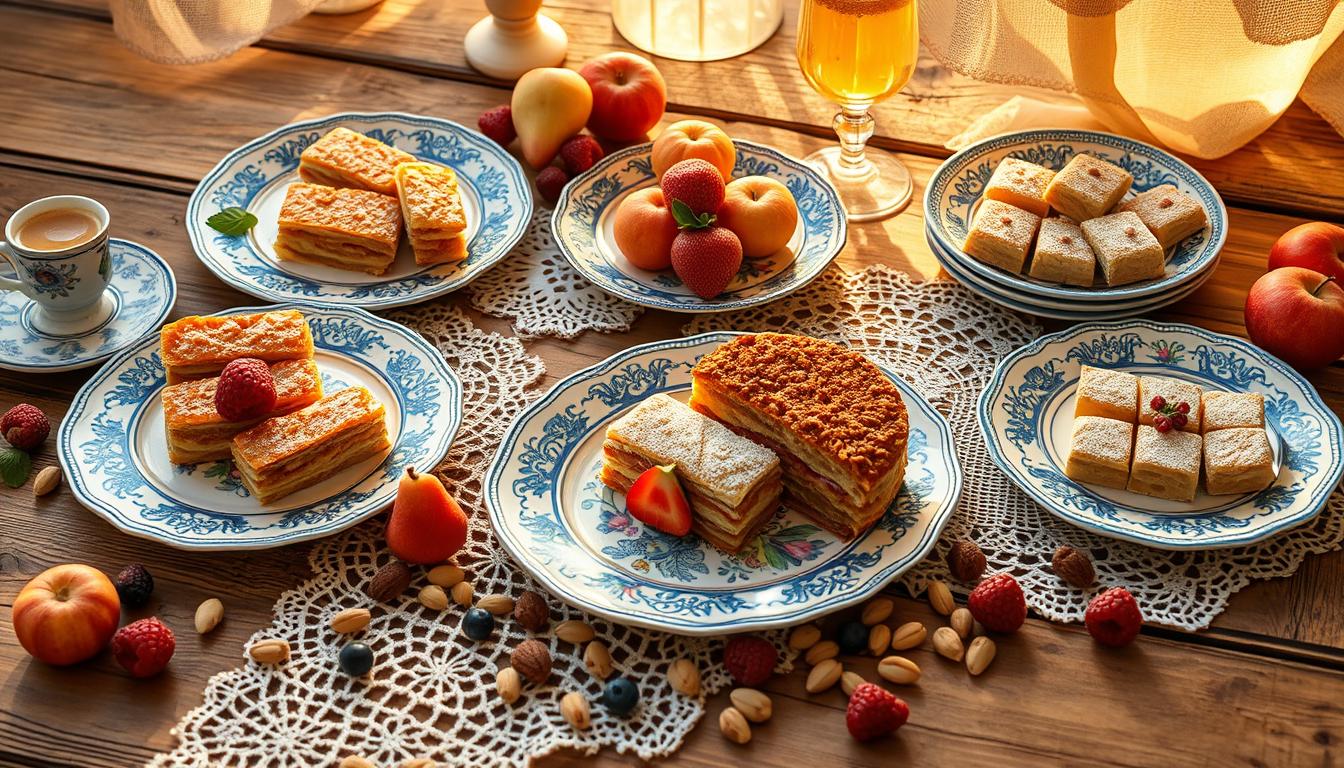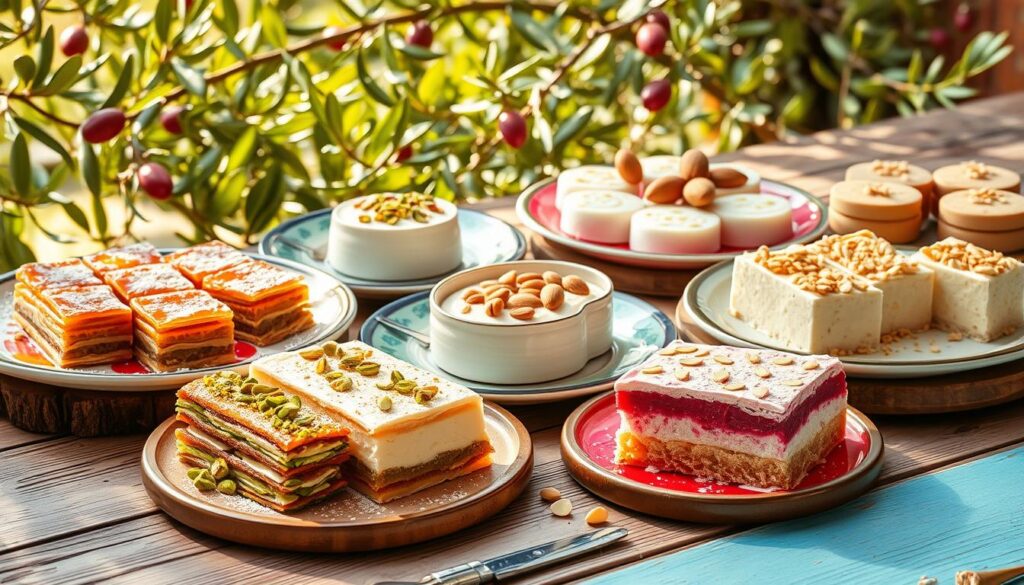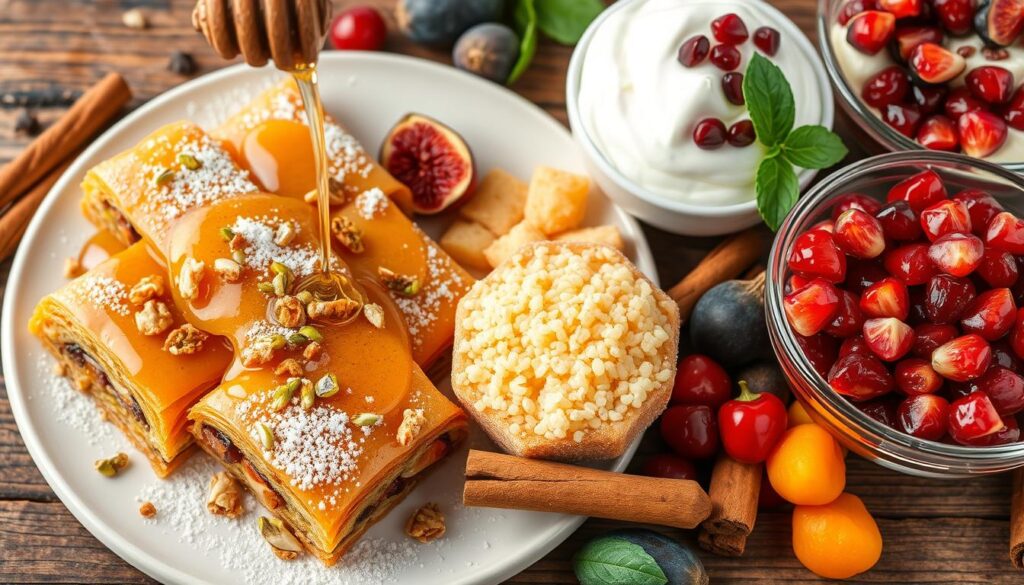Imagine walking through warm streets where the smell of baklava and cannoli fills the air. Mediterranean desserts are more than treats. They connect you to centuries of cooking traditions across 20 countries.
From the rich layers of tiramisu to the crunchy gelato, these desserts weave a colorful tapestry of tastes. Each bite shares stories of migration, conquest, and shared cooking heritage. This journey spans from Portugal to the Middle East.
These aren’t just desserts; they’re sensory experiences that show the heart of Mediterranean culture. Whether you love the nutty taste of baklava or the creamy cannoli, these treats take you on a journey through traditions and family recipes.
Get ready to dive into a world where every dessert celebrates life, connection, and the amazing variety of Mediterranean food. Your sweet journey starts now!
Introduction to Mediterranean Desserts
Mediterranean desserts are more than just sweet treats. They tell stories of culture, tradition, and family recipes. From creamy pastry creams to moist olive oil cakes, each dessert has its own unique flavor.
The world of Mediterranean sweets is full of flavors and textures. You’ll find desserts that mix old techniques with fresh ingredients.
What Makes Mediterranean Desserts Unique?
Mediterranean desserts are special because of their:
- Use of local, fresh ingredients
- Rich cultural heritage
- Natural sweeteners like honey
- Incorporation of nuts and spices
- Balanced flavor profiles
“Mediterranean desserts are not just food, they are a celebration of life and tradition.” – Dr. Nikoleta Kolovos
A Brief History of Mediterranean Sweets
The history of Mediterranean desserts goes back to ancient times. Greek, Roman, and Arab cultures influenced these treats. Panna cotta and olive oil cakes are examples of this rich history.
These desserts were once saved for special events. In Greece, sweets were given to guests as a sign of welcome. Mediterranean desserts are about making memories, not just eating.
- 16th-century traveling dervishes introduced Turkish coffee
- Moroccan desserts often feature dates and dried fruits
- Honey remains a primary natural sweetener
Popular Ingredients in Mediterranean Desserts
Mediterranean desserts are special because of their ingredients. These ingredients turn simple sweets into amazing treats. The region’s rich tradition uses natural, tasty parts to make every bite a joy.
Nuts and Seeds: The Crunchy Additions
Nuts are key in making Mediterranean desserts. Pistachios, almonds, and walnuts add unique textures and tastes. They make desserts not only delicious but also good for you.
- Pistachios: Offer a vibrant green color and rich, buttery flavor
- Almonds: Provide a delicate crunch and subtle sweetness
- Walnuts: Contribute an earthy, slightly bitter undertone
Honey: Nature’s Sweetener
Honey is the main sweetener in Mediterranean desserts. It’s different from sugar because it adds complex flavors and natural sweetness. This makes it perfect for mixing with other ingredients.
| Ingredient | Flavor Profile | Common Dessert Use |
|---|---|---|
| Pistachios | Buttery, rich | Baklava topping |
| Almonds | Delicate, mild | Cookie fillings |
| Walnuts | Earthy, robust | Pastry layers |
| Honey | Complex, floral | Syrup for desserts |
“In Mediterranean cuisine, ingredients are not just food—they’re a celebration of culture and tradition.”
Together, these ingredients make desserts that are more than just sweet. They are cultural expressions full of flavor and history.
Iconic Mediterranean Desserts You Must Try
The Mediterranean region is known for its sweet treats. These desserts, from layered pastries to stuffed cookies, come from a long history of culinary traditions. They reflect the region’s rich cultural heritage.
Each dessert has its own story of flavor, texture, and generosity. Let’s dive into three iconic treats that capture the sweet essence of this vibrant region.
Baklava: The Layered Delight
Baklava is a standout among Mediterranean sweets. It’s made with thin layers of phyllo dough, filled with chopped nuts, and then soaked in sweet syrup or honey. It’s a treat that takes about 30 minutes to make and comes from countries like Turkey and Greece.
- Ingredients: Phyllo dough, nuts, honey
- Preparation time: 30 minutes
- Flavor profile: Sweet and nutty
Knafeh: A Sweet Cheese Pastry
Knafeh is another amazing Mediterranean dessert. It combines kataifi dough with a creamy cheese filling, topped with pistachios and sweet syrup. Its detailed preparation highlights the region’s culinary skill.
“Knafeh is not just a dessert, it’s an experience of texture and flavor.”
Maamoul: Stuffed Cookies with Tradition
Maamoul are traditional cookies from the Middle East. They’re filled with dates, pistachios, or walnuts and enjoyed during religious holidays. Each bite connects you to family traditions and cultural celebrations.
- Fillings: Dates, pistachios, walnuts
- Occasion: Religious festivals
- Cultural significance: Family tradition
These desserts highlight the diversity and richness of Mediterranean sweets. They invite you to explore a world of delightful flavors.
Regional Variations of Mediterranean Desserts
The Mediterranean region is full of sweet treats that show off its rich culinary traditions. Each area adds its own twist to desserts, making for a tasty and cultural journey.
Mediterranean desserts are incredibly diverse, spanning different countries and cultures. From the Middle East to Greece, each place has its own special sweets. These treats not only delight the taste buds but also share stories of local traditions.
Middle Eastern Delights
Middle Eastern desserts are famous for their deep flavors and detailed preparations. Turkish delight is a classic favorite that has won hearts for ages. It comes in many flavors, like rosewater and pistachio.
- Rosewater-infused varieties
- Pistachio-studded versions
- Traditional lokum styles
These desserts often use special ingredients like dates, nuts, and spices. Treats like ma’amoul and qatayef show the creativity of Middle Eastern pastry chefs.
Greek Sweets
Greek desserts are a journey to the Mediterranean’s sunny coast. Loukoumades are a prime example – deep-fried dough balls in honey syrup that are irresistible.
| Dessert | Key Ingredients | Origin |
|---|---|---|
| Turkish Delight | Starch, Sugar, Rosewater | Turkey |
| Loukoumades | Flour, Honey, Yeast | Greece |
| Cannoli | Ricotta, Pastry Shell | Italy |
In Greece, desserts like galaktoboureko use phyllo dough. Italy’s cannoli adds another layer to Mediterranean dessert culture, with its crispy shells and sweet ricotta.
“Every dessert tells a story of its homeland, its people, and their culinary heritage.” – Mediterranean Food Enthuasiast
Looking for Turkish delight, honey-soaked loukoumades, or creamy cannoli? Mediterranean desserts have something for every sweet tooth. Each bite connects you to centuries of tradition and regional pride.
The Role of Desserts in Mediterranean Culture
Mediterranean desserts are more than just sweet treats. They show a deep cultural tradition of hospitality and connection. Each bite tells a story of family, celebration, and centuries-old culinary practices that bring people together.
In Mediterranean cultures, desserts play a key role in social interactions. They are not just food but a language of welcome and respect. When guests arrive, serving a delectable sweet is a key gesture of hospitality.
Celebratory Sweets: A Sign of Hospitality
The art of serving desserts reflects the region’s warm social customs. Different occasions call for specific festive desserts that symbolize community and shared experiences:
- Weddings feature elaborate dessert tables
- Religious holidays showcase traditional sweet specialties
- Family gatherings always include homemade treats
Festive Desserts and Traditions
Mediterranean festive desserts carry deep cultural significance. Consider these traditional sweets tied to specific celebrations:
| Dessert | Celebration | Cultural Significance |
|---|---|---|
| Baklava | Ramadan | Symbol of shared joy |
| Revani | Family Gatherings | Representing community bonds |
| Turkish Delight | Guest Reception | Hospitality ritual |
“In the Mediterranean, a dessert is never just a dessert—it’s a connection to heritage, family, and tradition.”
Understanding these culinary traditions offers a glimpse into the rich tapestry of Mediterranean culture. Every sweet represents a story of hospitality and shared moments.
Health Benefits of Mediterranean Sweets
Mediterranean desserts are more than just tasty. They use natural ingredients that help your health when eaten wisely.
Studies have found that Mediterranean-style sweets are very nutritious. The Lyon Diet Heart Study showed a 70% drop in death rates for those eating like Mediterraneans.
Natural Ingredients: Healthier Choices
Mediterranean sweets focus on natural ingredients. They often include:
- Nutrient-rich nuts like almonds and pistachios
- Honey as a natural sweetener
- Fresh fruits packed with vitamins
- Olive oil providing heart-healthy fats
“The quality of ingredients transforms a simple dessert into a nutritional powerhouse.” – Mediterranean Culinary Experts
Portion Sizes: Enjoying Desserts Responsibly
Controlling portion sizes is important for enjoying Mediterranean sweets without harming your health. Studies show that eating less dessert can make it more enjoyable and help your taste buds adjust.
By choosing smaller portions and focusing on quality, you can enjoy Mediterranean desserts guilt-free. The PRIDIMED study found that eating in moderation can lower heart disease risks.
- Aim for small, satisfying portions
- Savor each bite mindfully
- Choose desserts with nutrient-dense ingredients
How to Pair Mediterranean Desserts with Beverages
Finding the perfect drink to go with Mediterranean desserts can make your meal special. The right tea or coffee can make the dessert’s flavors pop, creating a perfect mix.
Mediterranean food is known for its rich flavors. Pairing these with the right drinks can make any dessert moment unforgettable.
Tea Pairings for Sweet Treats
Tea lovers will find Mediterranean desserts magical. Here are some top tea pairings:
- Mint tea with baklava: The cool mint balances the sweet, nutty pastry
- Sage tea alongside knafeh: Earthy notes enhance the cheese-based dessert
- Chamomile with light honey-based sweets: Offers a gentle, soothing contrast
Coffee: The Perfect Companion
Coffee is a big part of Mediterranean culture. Turkish coffee’s strong flavors pair well with rich desserts.
| Dessert | Recommended Coffee Style | Flavor Profile |
|---|---|---|
| Baklava | Strong Turkish Coffee | Intense, nutty complement |
| Galaktoboureko | Medium Roast Espresso | Creamy texture enhancement |
| Tiramisu | Dark Roast | Rich, deep flavor integration |
Pro tip: Use small, traditional cups for coffee or tea. This adds to the Mediterranean dining experience. Sharing these drinks with desserts is key.
“In the Mediterranean, dessert is not just food—it’s a celebration of life, friendship, and tradition.”
Recipes for Popular Mediterranean Desserts
Exploring Mediterranean desserts is a fun journey. It’s perfect for both new and seasoned cooks. These traditional sweets will take you to the lively Mediterranean.
Easy Baklava Recipe for Home Bakers
Making baklava at home is easier than you think. It’s a mix of flaky pastry, nuts, and sweet syrup.
- 30 large sheets of filo pastry
- 100g salted butter
- 300g pistachios
- 100g white sugar
- ¼ tsp ground cinnamon
Here’s what you need for the syrup:
- 250ml water
- 400g sugar
- 2 Tbsp lemon juice
- 2 Tbsp rose water
- 3 cardamom pods
- 5 cm cinnamon stick
- 125ml runny honey
Knafeh: A Step-by-Step Guide
Learning to make knafeh takes time and care. It’s a Middle Eastern treat with crispy pastry, cheese, and syrup.
“The secret to a perfect knafeh is in the delicate balance of textures and flavors.” – Mediterranean Dessert Chef
Here’s what you’ll learn about Mediterranean desserts:
| Nutrient | Per Serving |
|---|---|
| Calories | 162 |
| Carbohydrates | 25g |
| Protein | 3g |
| Fat | 6g |
With these recipes, you can make tasty and healthy Mediterranean desserts. Enjoy the real flavors of the Mediterranean in your kitchen.
Tips for Storing Mediterranean Desserts
Keeping Mediterranean sweets fresh is key. Whether it’s a flaky baklava or creamy knafeh, right storage keeps them tasty.
Best Practices for Freshness
Freezing Mediterranean desserts needs special care. Each dessert has its own way to stay fresh and flavorful.
- Store baklava in an airtight container at room temperature for up to two weeks
- Keep phyllo-based desserts away from moisture and direct sunlight
- Use glass containers for better preservation of delicate pastries
How to Freeze and Thaw Properly
Freezing Mediterranean desserts is an art. Many traditional sweets freeze well if done right.
- Wrap desserts tightly in plastic wrap
- Add an additional layer of aluminum foil for extra protection
- Label containers with the date of freezing
- Freeze most Mediterranean desserts for up to 3 months
“The secret to preserving Mediterranean desserts is understanding their unique ingredients and textures.” – Mediterranean Pastry Chef
For the best thaw, let frozen desserts thaw slowly in the fridge overnight. This keeps their texture and prevents moisture buildup.
Pro tip: Some nutty desserts like kataifi and baklava actually improve in flavor after a day of careful storage!
Conclusion: Embrace the Sweetness of the Mediterranean
Your journey through Mediterranean sweets opens a world of culinary magic. Each bite tells a story of centuries of tradition. From Greece’s delicate pastries to Italy’s rich flavors, like those at Christini’s Ristorante Italiano, it’s an adventure of taste.
The variety of Mediterranean sweets caters to all tastes. Enjoy a classic cannoli or a creamy tiramisu. These desserts share stories of family, tradition, and passion. They turn simple desserts into memorable experiences that honor centuries of culinary art.
Exploring Further: Discovering More Sweet Recipes
Your Mediterranean dessert adventure is just starting. Try new recipes at home and visit specialty restaurants. From sorbetto to crème brulee, each dessert offers a unique look into the Mediterranean’s culinary heritage. Let your taste buds lead you on this sweet journey.
Your Next Dessert Adventure Awaits!
The Mediterranean’s dessert world invites you to explore, taste, and celebrate. With every new recipe, you’ll discover more flavors, traditions, and cultural richness. Your dessert journey is just beginning. Enjoy every moment of this delicious adventure.
FAQ
What are Mediterranean desserts?
Mediterranean desserts come from over 20 countries around the Mediterranean Sea. They use honey, nuts, and spices for unique flavors. These sweets show the rich culinary traditions of Greece, Italy, Turkey, and the Middle East.
What are some popular Mediterranean desserts?
Famous desserts include baklava, with its layers of phyllo and nuts. There’s also cannoli, filled with ricotta cream. Tiramisu, made with coffee, is another favorite. Knafeh and maamoul, stuffed cookies, are also loved.
What ingredients are commonly used in Mediterranean desserts?
Ingredients like pistachios, almonds, and walnuts are common. Honey, semolina flour, and phyllo dough add to the flavors. Cinnamon, cardamom, figs, dates, and olive oil also play a part.
Are Mediterranean desserts healthy?
These desserts can be rich in calories. Yet, they use natural ingredients like nuts for healthy fats. The Mediterranean way is about enjoying them in moderation.
How long can Mediterranean desserts be stored?
Storage times vary. Baklava stays fresh for up to two weeks at room temperature. Many can be frozen for 3 months, wrapped well in plastic and foil.
What beverages pair well with Mediterranean desserts?
Mint tea, sage tea, and Turkish coffee are great matches. They balance the sweetness of the pastries, adding to the dessert experience.
Do Mediterranean desserts have cultural significance?
Yes, they hold deep cultural and religious meanings. Served at festivals and celebrations, they show hospitality and are key in community bonding.
Can I make Mediterranean desserts at home?
Definitely! Making baklava and knafeh at home is easy. You’ll need phyllo dough, nuts, honey, and basic baking skills.



